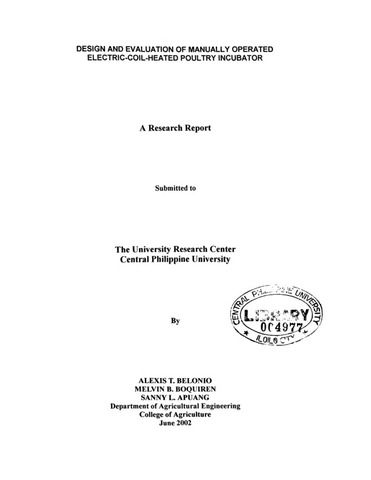Design and evaluation of manually-operated electric-coil-heated poultry incubator
요약
Manually-operated electric-coil-heated poultry incubators were designed and evaluated at the Appropriate Technology Center, Department of Agricultural Engineering, College of Agriculture, Central Philippine University, Iloilo City from April 2000 to August 2001.
Three different models of the incubator, ECH-500, -100, and -250 which differ in sizes, were commercially produced and evaluated both in the laboratory and in the actual field conditions. All the units basically used nichrome wire as heat source. The three models have common major parts, as follows: (a) a cabinet which is made of ¼-in. thick marine plywood and 2 in. x 2 in. S4S good lumber as chamber, (b) an egg tray which is made of ¼- in wire mesh screen with 1 in x 2 in. S4S good lumber as frame work, (c) a nichrome wire heater as heat source using four 600-watt wire connected in series to reduce the wattage available for heating, (d) air inlets and outlets for ventilation purposes, (e) a water pan made of aluminum to supply the required humidity, (f) an incandescent bulb for lighting purposes during inspection of eggs, (g) a thermostat to automatically control the temperature inside the incubator, and (h) a thermometer to measure the temperature inside the incubator cabinet.
Results of the study showed that the ECH-50 can load 40 to 80 eggs while ECH 100 can load 80 to 120 eggs either from quail, chicken or duck. The largest model, ECH 250 can load 250 to 300 eggs of either of the three kinds of poultry eggs mentioned. All the three models can supply and maintain the required temperature of 37.5 C with a variation of 36.0 to 37.8 C. Relative humidity varies from 65 to 70%. Hatching percentage was found high, i.e. above 70% for duck and chicken eggs when they are properly operated and maintained. However, quail eggs were observed to have lower hatching percentage of 30 to 37% which can be attributed to heterogenity of the eggs. Furthermore, it was found out that eggs transported from one place to another place prior to incubation were found to have lower hatching percentage (40% and below) than those which were not transported.
Electrical power input of the incubators obtained were 154 watts for ECH-50 and -100 while 254 watts for ECH-100. Power consumption rate ranges from 0.025 to 0.042 kW - hour for one hour operation.
A unit of incubator requires an initial investment of P6,500 for the smallest model and P9,500.00 for the largest model. Operating cost analysis showed that the largest model (ECH-250) has the lowest incubation cost ofP2.70 per egg hatched while the smallest model (ECH-50) has the highest incubation cost of P8.84 per egg hatched.
Furthermore, cost return analysis showed that operating the incubators for a period of 10 months per year can provide a net income of P5,656.00 to P42,027.00 for one year assuming the cost of eggs is P3.50 and the selling price for hatched chick is P30.00. The return on investment ranges from 87.01% to 42.39% and the benefit-cost ratio ranges from 1.83 to 8.89. Payback period for all models is less than 13 months
기술
Abstract only
추천 인용
Belonio, A. T. , Boquiren, M. B. & Apuang, S. L. (2002). Design and evaluation of manually-operated electric-coil-heated poultry incubator (Research report). Jaro, Iloilo City: University Research Center, Central Philippine University.
유형
Technical Report주제
선반 위치
GSL 630.72 B418
물리적 설명
iv, 30 leaves: color illustrations
Collections
- Research reports [167]
- Research reports [37]


